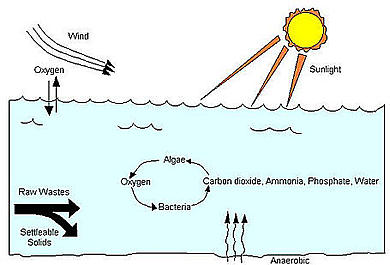

Types & Functions of Waste Stabilization Ponds
WSPs are of Two types;
- Single pond or Primary facultative pond and
- Multi-cell pond system.
Single Pond or Primary Facultative Lagoon
In general, the wastewater in facultative lagoon naturally settles into three fairly distinct layers or zones. Different conditions exist in each zone, and wastewater treatment takes place in all three.
The top layer in a facultative lagoon is called the aerobic zone, because the majority of oxygen is present there. The depth of the aerobic zone is depends on loading, climate, amount of sunlight and wind, and quantity of algae presnet in the water. The wastewater in this part of the lagoon receives oxygen from air, from algae, and from the agitation of the water surface from wind and rain. This zone also serves as a barrier for the odors from gases produced by the treatment processes occurring in the lower layers.
The anaerobic zone is the layer at the very bottom of the lagoon where no oxygen is present. This area includes a layer of sludge, which forms from the solids that settle out of the wastewater. Here, wastewater is treated by anaerobic bacteria, microscopic organisms, such as certain protozoa, and sludge worms, all of which thrive in anaerobic conditions.
The middle layer called facultative zone, includes the facultative, intermediate, or aerobic- anaerobic zone. Both aerobic and anaerobic conditions exist in this layer in varying degrees. Depending on the specific conditions in any given part of this zone, different types of bacteria and other organisms are present that contribute to wastewater treatment.
Throughout facultative lagoons, physical, biological, and chemical processes take place that result in wastewater treatment. Many of these processes are interdependent. For example, on the surface, wind and sunlight play important roles. Surface agitation of any kind adds oxygen to the wastewater. For this reason, facultative lagoons are designed to make the best use of wind in the area. The amount of wind the lagoon receives is not only important for the oxygen it contributes, but also because it affects the overall hydraulic flow pattern of the wastewater inside the lagoon, which is another physical factor that contributes to treatment.
the wastewater to settle and for many disease-causing bacteria, parasites, and viruses to either die off or settle out. Time also allows treatment to reduce the overall organic strength of the wastewater, or its biochemical oxygen demand (BOD). In addition, some of the wastewater eventually evaporates.
Leave a Reply







 LIKE TO GET UPDATES
LIKE TO GET UPDATES  TO GET EXPERT GUIDE
TO GET EXPERT GUIDE